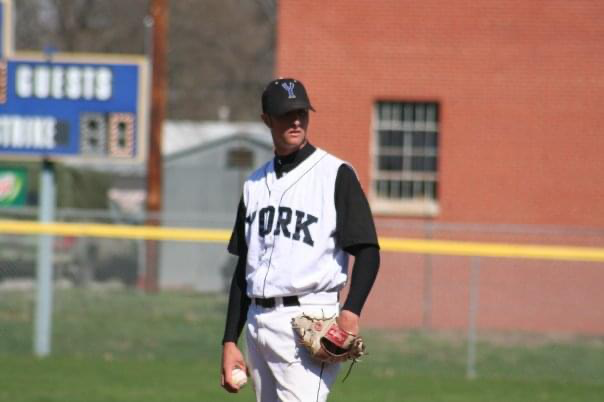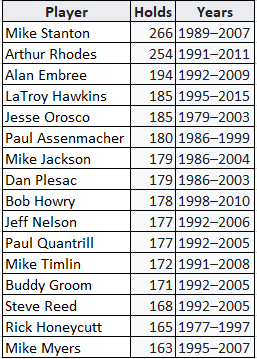A popular stat in baseball and category in fantasy baseball for pitchers is “holds”. Holds used to not be calculated or really looked at until the last 30+ years, and really a lot more over the last decade.
What is a hold in baseball?
A hold is when a relief pitcher enters a game in a save situation and maintains their team’s lead for the next relief pitcher, while recording at least one out.
A hold is an unofficial stat that is used to measure a relief pitcher’s effectiveness. The hold was invented in 1986 by John Dewan and Mike O’Donnell because of the vast majority of relief pitchers who were used but to not close the game.
Like a save, which is a measurement of a closer’s effectiveness, a hold is used to measure a relief pitcher’s effectiveness.
Think of a hold as simply holding a lead. It’s holding a lead for the next middle reliever or closer.
Holds are most often used in the 7th and 8th inning, where middle relievers or setup pitcher’s come into the game in relief of the starting pitcher.
They are the pitchers who bridge the gap from the starting pitcher to the closer.
Just like a closer with saves, a relief pitcher with a lot of holds means they do a great job of persevering their teams lead when they enter the game.
A closer doesn’t want multiple blown saves just as a relief pitcher doesn’t want blown holds.
The job of a relief pitcher, both middle relievers and closers is to preserve and hold their team’s lead.
Unlike wins, losses, and saves, more than one pitcher can earn a hold for a game. Thought it’s not possible for a pitcher to be awarded more than one hold in the same game.
Contents
- How is a Hold awarded?
- #1, Enters the game in a save situation.
- #2, Records at least one out.
- #3, Leaves the game before it has ended without their team having given up the lead at any point.
- How many innings is a hold?
- Can you get a hold if your team loses?
- Who has the most holds in MLB history?
- Career Holds Leaders – MLB (post 1999 start)
- MLB (Pre 1999 start), if you go back and recalculate
- Final Word
How is a Hold awarded?
The bottom line of a hold is being able to hold your team’s lead when called upon to pitch.
There are several get a hold in baseball. To be awarded a hold, a pitcher must meet 3 criteria:
- Enters the game in a save situation
- Records at least one out
- Leaves the game before it has ended without their team having given up the lead at any point
There’s more detail to each of the 3 above.
#1, Enters the game in a save situation.
For this to hold true, the pitcher must:
- Appear in relief (not be the starting pitcher) when their team is leading; and
- Not the pitcher awarded the win
- Qualifies for one of the following circumstances
- Enters the game with a lead of no more than 3 runs and maintains that lead for at least one inning
- Enters the game with the potential tying run either on base, at bat, or on deck
- Pitches for at least 3 innings
#2, Records at least one out.
For this to hold true, the pitcher must:
- Get at least one out while pitching
#3, Leaves the game before it has ended without their team having given up the lead at any point.
For this to hold true, the pitch must:
- Not be the pitcher awarded the save
- Not be the last pitcher of the game, when the game ends
How many innings is a hold?
There’s isn’t necessarily a number of innings pitched needed to be awarded a hold in baseball. It all depends on the situation when the pitcher comes into relief.
If the relief pitcher is brought in with no runners on base and no outs, then they must pitch at least one inning and hold the lead to be eligible for a hold.
But a pitcher can also come into relief with the potential tying run on base, at bat, or on deck.
This could happen with more than no outs. If that pitcher comes out of the game without any of those players (baserunner, batter, on deck) to score, then they would be awarded a hold.
A relief pitcher can also get a hold if they come into the game with a lead of any amount, and pitch at least 3 innings without giving up the tying run, that would also get them a hold.
However, there are ways a pitcher can leave a game with what looks like a hold, but then no hold is counted.
If a relief pitcher meets all the criteria for a hold but allows a baserunner before they leave the game, and that runner ends up scoring to tie or give up the lead, no hold would be awarded.
They are responsible for that baserunner.
There is no requirement to the number of innings minimum needed to pitch to get a hold. At least one out has to be recorded though, so you could say at least .1 innings pitched, or 1/3 of an inning pitched, at minimum.
Can you get a hold if your team loses?
One additional key thing to remember is a pitcher can receive a hold by protecting a lead even if that lead is blown or lost later after they leave the game.
If a relief pitcher meets all criteria for a hold but their team loses later in the game, they can still be awarded a hold. Yes, you can get a hold if your team loses.
For example, say in the 8th inning a relief pitcher is brought in with a 3-run lead. That pitcher gets 3 outs without any runs scoring. Hold is in place.
But then in the 9th inning the closer blows the game by giving up 4 runs, the relief pitcher who held the lead still receives a hold. Even if the game is lost and the closer received a blown save.
The relief pitcher still did their job of holding the lead when they came in and out of the game. So, they still get a hold.
A relief pitcher who comes in with a lead and ends up giving up the lead and go ahead run, what happens? That pitcher obviously doesn’t get a hold because they blew the lead, but if the game finishes as a loss with their team ever coming back to tie, they would be given the loss.
Again, there is always one winner, one loser, and sometimes a save in a baseball game. One of each. But there can be multiple players awarded holds. Holds can even be awarded to two different pitchers on two different teams in the same game.
Who has the most holds in MLB history?
The main goal of a relief pitcher is to hold their team’s lead. Now that’s obviously not true if a pitcher is brought into a game while losing.
At that point your job is to just prevent any more runs from scoring. Being able to hold your teams lead not only takes being a talented relief pitcher, but it also takes a high level of strong mentality.
Much like a closer, a relief pitcher holding a lead takes mental toughness. To not let an opposing offense score on you when they are doing anything they can to manufacture runs.
Tony Watson announces retirement after 11 seasons in the big leagues, per @stephenjnesbitt
— B/R Walk-Off (@BRWalkoff) April 18, 2022
Watson was an All-Star in 2014 with the Pirates and is MLB’s all-time leader in holds. pic.twitter.com/xiqSIzoQGt
Tony Watson, who pitched for the Pittsburgh Pirates, Los Angeles Dodgers, and San Francisco Giants currently holds the record for most holds in MLB History. In fact, Watson holds the record for most holds in a career and tied for the most holds in a season.
Watson has a career total of 234 holds. 152 with the Pirates, 74 with the Giants, and 8 with the Dodgers. He is now retired.
Tony Watson with the Pirates in 2015 and Joel Peralta with the Tampa Bay Rays in 2013 hold baseballs single season holds record at 41 each.
Two others, Tyler Clippard and Luke Gregerson each had 40 in a single season.
Now pitching: Tony Watson
— SFGiants (@SFGiants) June 2, 2018
Giants 3, Phillies 0 | Top 7
#OrangeFriday #SFGiants pic.twitter.com/q0eLiAaKDP
There are only 4 active pitchers within somewhat striking distance of catching Tony Watson, but all are on the backend of their careers and average less than 20 holds per season.
Baseball really started counting Holds season by season starting in 1999. So the record books look like this:
Career Holds Leaders – MLB (post 1999 start)
MLB (Pre 1999 start), if you go back and recalculate
Final Word
A hold in baseball is now one of the more popular and well used baseball stats for pitchers. It’s extremely important for relief pitchers to hold their teams lead when they come into a game.
Just a closer is brought in the close out the game with a win, a relief pitcher who is brought in with the lead is expected to hold that lead.
The hold is a counting stat, meaning there isn’t a formula or calculation like batting average or on base %. Instead, it’s you either held the lead or you didn’t.
Now there are certain criteria to be met to be awarded a hold, due to the numerous situations a relief pitcher can be brought into during a game.
But the bottom line of a hold in baseball is a hold is awarded to a relief pitcher who comes into a game with a lead, records at least one out, and leaves the game with the lead still intact.



